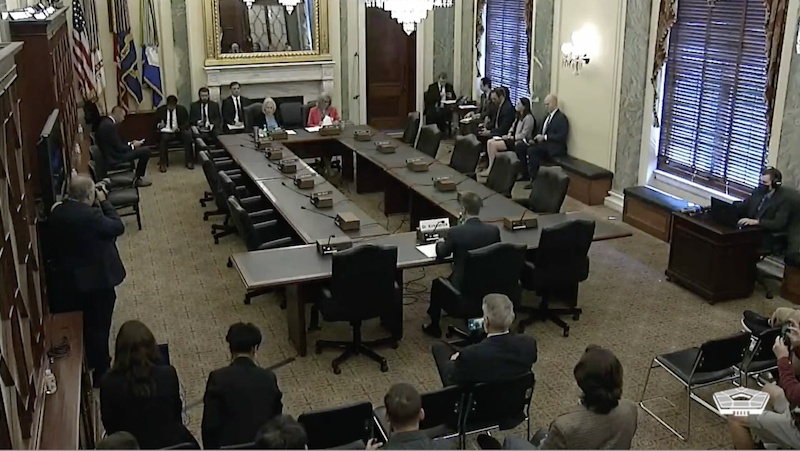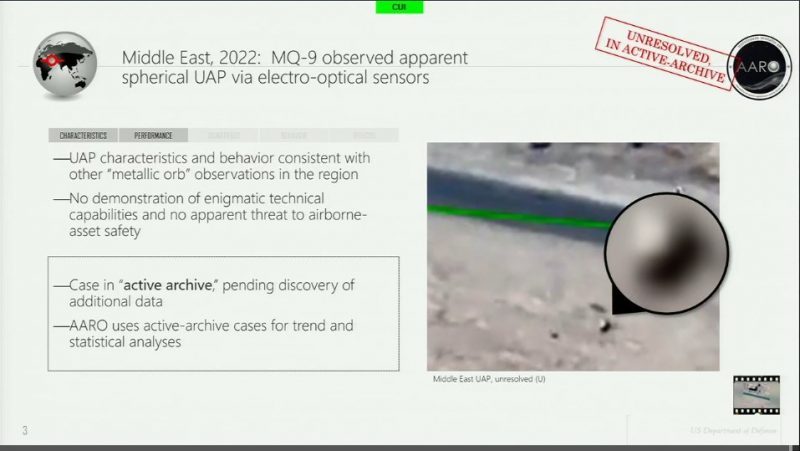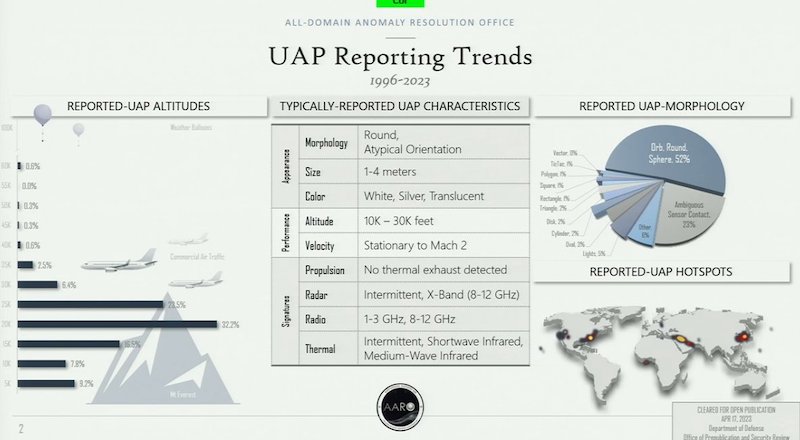
On Wednesday, April 19, 2023, the Senate Armed Services Committee on Emerging Threats and Capabilities in the U.S. Congress held a new hearing on UFOs, known to the U.S. military as Unidentified Anomalous Phenomena (UAP). This was the second congressional hearing on the issue since the last one, in the U.S. House, on May 17, 2022. So there was more talk. But – as has been the case for the past 70+ years, since UFO stories became popular following the development of rocketry after World War II – there is no credible evidence for the existence of aliens, or of UFOs that defy physics.
The hearing was in two parts, a closed session and a public one that followed immediately after.
Sean Kirkpatrick, the Director of the Pentagon’s All-domain Anomaly Resolution Office (AARO), was the sole witness giving testimony at the April 19 hearing. Senator Kirsten Gillibrand (D-NY) led the proceedings as the Chairwoman. Gillibrand has been instrumental in pushing the UAP issue forward in recent years.
The hearing had a perfunctory aspect. Its primary purpose was to provide “testimony on the mission, activities, oversight and budget of the All-Domain Anomaly Resolution Office (AARO),” which had been founded less than a year ago (in July 2022) following the previous hearing in the U.S. Congress.
The Department of Defense also published its own press release on the day of the hearing, April 19.
Senate UFO hearing focuses on AARO
This particular hearing wasn’t about “proving” any particular theory as to what is happening in the skies. Rather, it focused primarily on AARO itself and how it is fulfilling (or not) the mandates given to it by Congress. Reactions to the hearing have been mixed. Some people think it was another step forward on government transparency on the issue of UAP. But others saw it as the opposite … just more smokescreen from the U.S. government on the subject. And still others saw it as neither thing – neither a step forward, nor a smokescreen – but just more hot air in the category of much ado about nothing. After all, U.S. Congresspeople are just people. They are as susceptible, or as unsusceptible as the case may be, to the subject of UFOs.
In any event, most people were not expecting major revelations from the April 19 hearing. And indeed there were no major revelations.
But some interesting nuggets of information were discussed, some of which displayed a high degree of (perhaps uncalled-for) credulity on the subject of UFOs.
For example, Gillibrand began the hearing by stating:
We don’t know where they come from, who made them or how they operate. We cannot keep turning a blind eye to surveillance data that is critical to detecting and tracking UAP.
And the fact is … we don’t know there is a “they.” There’ve only been “sightings” and blurry images (camera artifacts?) on images and videos. There’s been no hard evidence and no clear images of “them,” so far.
But Gillibrand’s statement reflects the belief of many that – for the past several years in particular (but also going back decades) – unknown objects have appeared to fly into restricted military airspace with apparent impunity. Are they real? We don’t know. While, as with UAP reports in general, most cases can be explained after investigation and analysis, there are still some that have been more difficult to explain. Those are the ones that, by mandate, AARO is required to focus on. Those cases, from the U.S. Navy in particular, have been the focus of many media reports (both good and bad) in the past several years.
And, for the military, the UAP issue has largely been one of “national security” and air safety. They can’t look away.
New UAP videos
So there were no bombshells in the April 19 hearing. But there were some new blurry images.
For example, Kirkpatrick showed three new UAP videos. These were the Middle East UAP, South Asia UAP 1 and South Asia UAP 2. Kirkpatrick presented these as examples of solved and unsolved cases. The two South Asia clips, reportedly from the same event, show a distant oblong object. An MQ-9 Reaper drone took that footage earlier this year. Kirkpatrick stated that analysis showed the object was most likely a commuter plane.
The other video clip, however, from 2022, is more interesting. Kirkpatrick said that this one remains unsolved. It shows what looks like a small metallic orb or sphere moving quickly across the field of view. An M-Q Reaper drone also obtained this footage, in the Middle East. The Reaper drone is stationary and hovering as the object comes into view at the top of the frame. The drone’s camera then pans down to try to keep up with the object as it passes below.
Kirkpatrick stated that while the object showed no “enigmatic” behavior, it was consistent with other similar reports from the Middle East in recent years. Indeed, Researcher and filmmaker Jeremy Corbell recently released a still frame from another military video taken in Iraq. That one, nicknamed the Mosul Orb, is from April 16, 2016, and looks much like the newest one shown in the hearing.
Could they be balloons or drones? Possibly, although Kirkpatrick stated that at least the 2022 one is still regarded as unknown.
Watch the Middle East UAP video below:
650 UAP cases mentioned in UFO hearing
Kirkpatrick stated that the current number of UAP reports that AARO has received is 650. Those incidents run from 1996-2023. Of those, 52% fall into the category of apparent spheres or orbs. Ambiguous sensor contacts are next at 23%. Of interest to UFO advocates is that some of the shapes listed are those that have been commonly known in UFO reports since the 1940s: discs, triangles and cylinders. And these make up 2% of the reports.
The tic-tac shape is also included. This is interesting, since it was largely due to the new reporting on UAP, which started on December 16, 2017, with the New York Times story that mentioned the now-famous tic-tac case from 2004. That was when Navy pilots and other crew members on the USS Nimitz reported seeing and tracking multiple tic-tac-shaped objects for about two weeks. This was in training airspace off the coast of California.
They described the objects as white, shaped like a Tic Tac candy and about 40 feet long. No observable wings, propellers, engines or exhaust. The objects reportedly could descend from about 80,000 feet to 20,000 feet in 0.87 seconds. And then just as quickly down to just above the surface of the ocean.
Typical UAP characteristics
A slide that Kirkpatrick showed also described the most typically reported UAP characteristics as round (the spheres), and 1-4 meters in size. Speeds described as from stationary to Mach 2 (1,500 mph). No exhaust seen. This would seem to correlate with what former Navy fighter pilot Ryan Graves has described. He and other pilots say that they encountered these kinds of objects almost daily for weeks, primarily in 2015-2016 off the East Coast of Virginia.
These were primarily the small spheres, translucent with dark gray cubes inside them. Graves said they would “loiter” for days or weeks at a time, sometimes remaining stationary, even in strong winds, and sometimes accelerating to supersonic speeds. More recently, the same objects are reportedly being seen off both coasts now.
Graves now heads a new UAP committee for the well-known American Institute of Aeronautics and Astronautics (AIAA). He wrote an excellent piece for POLITICO on February 28, 2023.

Following the scientific evidence
While the most recent ODNI UAP report, released on January 12, said that most of the UAP cases can be explained (510 total at that time), around half still remained as unsolved. Can they be solved? For his part, Kirkpatrick, also a physicist, says he is committed to the scientific method. He said:
We cannot answer decades of questions about UAP all at once, but we must begin somewhere. While I assure you that AARO will follow scientific evidence wherever it leads, I ask for your patience as DoD first prioritizes the safety and security of our military personnel and installations in all domains.
Without sufficient data, we are unable to reach defendable conclusions that meet the high scientific standards we set for resolution, and I will not close a case that we cannot defend the conclusions of. I should also state clearly for the record that in our research, AARO has found no credible evidence thus far of extraterrestrial activity, off-world technology, or objects that defy the known laws of physics.
Indeed, as with civilian sightings, most UAP reports turn out to have mundane explanations. It’s the ones that don’t, even if only a few percent, that are of the most interest. Whether those represent previously unknown technologies from adversarial nations … or something else, is the big question. One problem so far has been a lack of enough data. Much of that data is classified. AARO has only been operating for nine months so far, and Kirkpatrick acknowledged that it currently has only limited access to Title 50 classified information, which would hamper its ability to analyze all of the available data.
Whistleblowers?
In addition, there have been growing reports and rumours that so-called whistleblowers have been providing testimony to AARO in recent months. The FY 2023 National Defense Authorization Act (NDAA), signed by President Biden into law last December, contains language specifically providing a means for this to be done to some extent, without risks of repercussions. To be sure, Kirkpatrick confirmed that AARO has spoken with several people so far. Whether anything more comes of this remains to be seen. You can read the UAP portion of the NDAA here.

Little mention of Chinese spy balloon in UFO hearing
The hearing did not focus on the recent shoot-downs of the Chinese spy balloon and other three objects last February. The Chinese spy balloon would not fall under AARO’s purview, since AARO is tasked to deal only with objects that are unknown and unidentified. Even with the other three objects, AARO had limited involvement. Kirkpatrick said:
We did not play a role, other than that initial advice on what you are seeing, and how you are seeing it. Beyond that, I would have to refer you back to the White House.
You can watch the full hearing here. You can also read Kirkpatrick’s full statement given to AARO, before the questions, here.
At the time of this writing, there are also reports that the House will hold its next UAP hearing sometime around mid-June 2023. That one is expected to have more witnesses testify.
U.S Space Force
On a related note, Major General John Olson, Mobilization Assistant to the Chief of Space Operations for the U.S. Space Force, mentioned (in part) at a Foreign Press Center (FPC) briefing on April 14:
I’ve gotten that question a couple other times, what do you think about UFOs or aliens? And quite frankly, having flown 83 different airplanes and had lots of hours, we’ve all seen lots of unexplainable elements. And the cosmos, the space realm is so large. If we look at the Earth, it is this tiny blue dot in an unlimited, almost incomprehensibly large cosmos. I personally believe that there absolutely, from a probability perspective, is life out there.
I think the second part of your question was related to UAP, or unidentified aerial phenomenon, and that UAP Task Force. And as far as I’m concerned or am knowledgeable about that, I do believe it does involve collaborative inputs and information exchange with all kinds of countries around the globe, because I think these are not just solely actions or events that occur within the confines of the United States. They’ve occurred globally, and I think we’re collecting that information.
Bottom line: The Senate held a new congressional UFO hearing on April 19, 2023. It focused on the Pentagon’s program AARO but also revealed interesting new videos and data.
Via Senate Armed Services Committee
The post UFO hearing in Senate: New videos but no hard evidence first appeared on EarthSky.
0 Commentaires